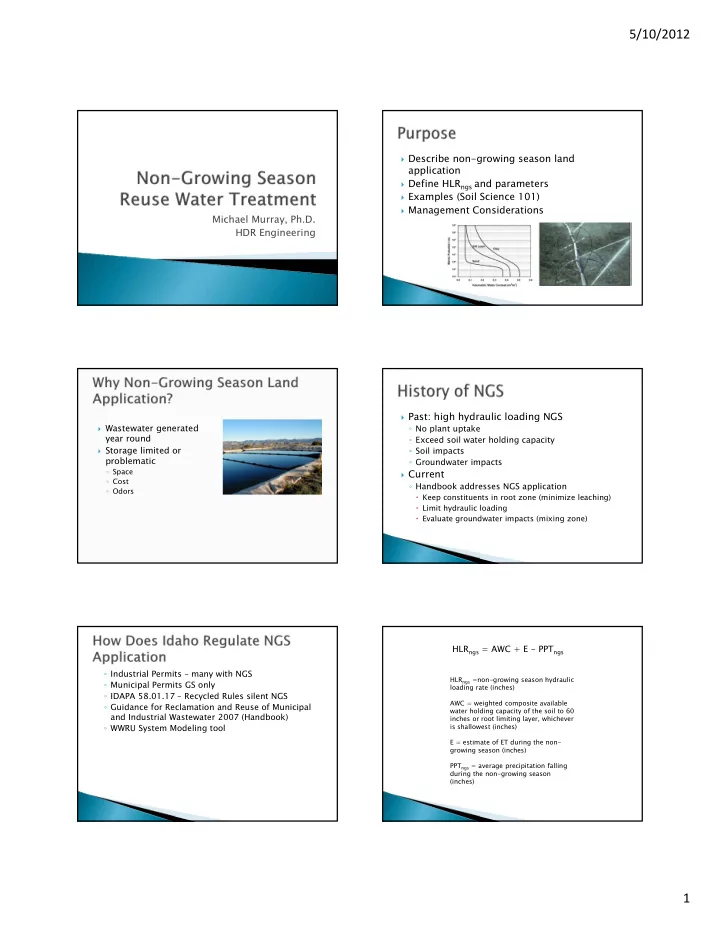

5/10/2012 Describe non-growing season land application Define HLR ngs and parameters Examples (Soil Science 101) Management Considerations Michael Murray, Ph.D. HDR Engineering Past: high hydraulic loading NGS Wastewater generated ◦ No plant uptake year round ◦ Exceed soil water holding capacity Storage limited or ◦ Soil impacts problematic ◦ Groundwater impacts ◦ Space Current ◦ Cost ◦ Handbook addresses NGS application ◦ Odors Keep constituents in root zone (minimize leaching) Limit hydraulic loading Evaluate groundwater impacts (mixing zone) HLR ngs = AWC + E - PPT ngs ◦ Industrial Permits – many with NGS HLR ngs =non-growing season hydraulic ◦ Municipal Permits GS only loading rate (inches) ◦ IDAPA 58.01.17 – Recycled Rules silent NGS AWC = weighted composite available ◦ Guidance for Reclamation and Reuse of Municipal water holding capacity of the soil to 60 and Industrial Wastewater 2007 (Handbook) inches or root limiting layer, whichever ◦ WWRU System Modeling tool is shallowest (inches) E = estimate of ET during the non- growing season (inches) PPT ngs = average precipitation falling during the non-growing season (inches) 1
5/10/2012 HLR ngs = AWC + E - PPT ngs Example HLRngs Southern Idaho Soil Moisture: (November through March) ◦ Θ : Volumetric water content, volume water/bulk volume soil Management (cm 3 /cm 3 ) Unit Parameter Comment ◦ Θ g: Gravimetric water content, mass water/mass dry soil (g/g) (inches) ◦ θ = ( ρ b/ ρ w) X θ g (typical ρ b 1.5 g/cm 3 ) AWC 10.8 NRCS Average E 2.4 ET Idaho Field capacity, wilting point, and saturation: Precipitation 5.8 Historic weather data (average) 7.4 Proposed NGS Calculated: AWC + E – PPTngs Limit 7.4 acre-inches/acre. If we had 200 acres, result in 40 MG of wastewater applied over the NGS HLR ngs = AWC + E - PPT ngs AWC = θ fc - θ wp Available Water Holding Field Capacity Permanent Wilting Point Soil Texture Capacity θ – volumetric water content Sand 0.10 0.05 0.05 Fine Sand 0.15 0.06 0.09 Sandy Loam 0.20 0.07 0.13 fs: 0.15 and 0.06 Fine Sandy Loam 0.25 0.08 0.17 Sil: 0.31 and 0.10 Loam 0.29 0.09 0.20 C: 0.40 and 0.23 Silt Loam 0.31 0.10 0.21 Clay Loam 0.39 0.18 0.21 Clay 0.40 0.23 0.17 Water tension – matrix potential – capillarity and adsorption forces 10” by 10” square box with silt loam soil Depth AWC ̴ 0.21 in. water/in. soil (or 2.1 inches AWC) Add 0.4 in. water 2.1” – 0.4” = 1.7” AWC remaining. 0.4” water X (1”soil/0.21”water) = about 2 inches depth. Use HYDRUS 2D/3D – numerical water and solute transport software Z X 0.000 0.038 0.076 0.113 0.151 0.189 0.227 0.265 0.302 0.340 0.378 0.416 Silt loam: θ fc = 0.31 Water Content - th[-], Min=0.104, Max=0.309 θ wp = 0.10 Project Bucket 1 - Silt loam soil with 1 cm water Results, Water Content, Time 72 - 72.0 hours 2
5/10/2012 HLR ngs = AWC + E – PPT ngs ◦ Apply wastewater: Day 2 (2.5”) and Day 3 (2.5”) ◦ Run model for 80 days ◦ Handbook: ◦ 5 inches of wastewater. Predict 3” deep drainage (AWC 2.1”) Lysimeter data Kimberly ◦ HYDRUS estimated 3.5” drained water ET X K (bare soil or reference crop X K) Free or Deep Drainage Boundary Flux ◦ ET Idaho (U of I, Kimberly Research Station) 250 Penman-Monteith Method 200 Bare Soil or Crop (Actual daily ET or Potential Daily ET) 150 100 50 0 0 10 20 30 40 50 60 70 80 Time [days] ◦ Wilder Area for NGS (Nov 1 2007 through March ◦ Wastewater: Day 3 (1.0”); Day 10 (1.5”), run 80 days 2008). ◦ Compare results with and without E . ◦ E = 0.02”/day (typical Dec and Jan) total 1.6” ◦ Daily ppt and E (ET Idaho) ◦ Without E: 2.5” – 2.1” = 0.4” deep drainage ◦ Silt loam 60”; ppt = 7.05”; E= 3.75” ◦ HYDRUS predicts 0.8” without E ◦ HYDRUS predict 0.03” with E ◦ HLR ngs = AWC + E - PPT ngs = 12.6” + 3.75” – 7.05” = 9.3” ◦ Free or Deep Drainage Boundary Flux Free or Deep Drainage Boundary Flux 4 ◦ Run w/o ww irrigation 4.0 3.5 3.5 3 ◦ Run with 9” of wastewater 3.0 2.5 2.5 2.0 2 1.5 1.5 1.0 1 0.5 0.5 0.0 0 0 10 20 30 40 50 60 70 80 0 10 20 30 40 50 60 70 80 Time [days] Time [days] Water Content, Time 151 - 151.0 days Actual Atmospheric Flux 0.24 0.5 0.22 0.20 0.0 ◦ Going into NGS: 0.18 -0.5 0.16 % AWC? -1.0 0.14 0.12 Opportunity to allow soils to dry? -1.5 0.10 0 20 40 60 80 100 120 140 160 -2.0 ◦ During NGS: Length [cm] 0 20 40 60 80 100 120 140 160 Time [days] Potential Atmospheric Flux Timing of application versus precipitation events Water Content, Time 151 - 151.0 days 0.5 0.34 ◦ Crop type: 0.0 0.33 -0.5 0.32 Deep rooted perennial crop 0.31 -1.0 0.30 -1.5 Winter wheat or Barley 0.29 -2.0 0.28 -2.5 Bare soil 0.27 -3.0 0.26 0 20 40 60 80 100 120 140 160 0 20 40 60 80 100 120 140 160 Time [days] Length [cm] Silt loam: Deep Percolation 2.2 to 4.1” θ fc = 0.31 θ wp = 0.10 3
5/10/2012 ◦ Percolation will occur! Key: keep nutrients near surface (ammonium versus nitrate) Manage soil water GW mixing analysis HDR Engineering 5/10/2012 20 4
Recommend
More recommend